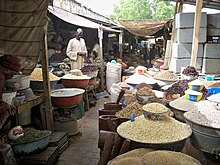 Petit Marché in Niamey | |
| Currency | West African CFA franc (XOF) |
|---|---|
| €1 = 655.957 XOF | |
Trade organisations | AU, AfCFTA, ECOWAS, CEN-SAD, WTO |
Country group | |
| Statistics | |
| GDP | |
GDP growth |
|
GDP per capita | |
GDP by sector |
|
| 2.740% (2018)[3] | |
Population below poverty line | |
| 34.3 medium (2014)[8] | |
Labour force | |
Labour force by occupation |
|
| Unemployment | 2.6% (2016 est.)[5] |
Main industries | Uranium mining, petroleum, cement, brick, soap, textiles, food processing, chemicals, slaughterhouses[5] |
| External | |
| Exports | $1.177 billion (2017. est)[5] |
Export goods | Uranium ore, livestock, cowpeas, onions[5] |
Main export partners | |
| Imports | $2.194 billion (2017. est) |
Import goods | Food, machinery, vehicles and parts, petroleum, cereals[5] |
Main import partners | |
Gross external debt | $3.09 billion (31 December 2017 est)[5] |
| Public finances | |
| Revenues | $1.68 billion (2017. est)[5] |
| Expenses | $2.235 billion (2017 est.)[5] |
All values, unless otherwise stated, are in US dollars. | |
The gross domestic product (GDP) of Niger was $16.617 billion US dollars in 2023, according to official data from the World Bank. This data is based largely on internal markets, subsistence agriculture, and the export of raw commodities: foodstuffs to neighbors and raw minerals to world markets.[12] Niger, a landlocked West African nation that straddles the Sahel, has consistently been ranked on the bottom of the Human Development Index, at 0.394 as of 2019. It has a very low per capita income, and ranks among the least developed and most heavily indebted countries in the world, despite having large raw commodities and a relatively stable government and society not currently affected by civil war or terrorism. Economic activity centers on subsistence agriculture, animal husbandry, re-export trade, and export of uranium.
The 50% devaluation of the West African CFA franc in January 1994 boosted exports of livestock, cowpeas, onions, and the products of Niger's small cotton industry. Exports of cattle to neighboring Nigeria, as well as groundnuts and oil remain the primary non-mineral exports. The government relies on bilateral and multilateral aid – which was suspended briefly following coups in 1996 and 1999 – for operating expenses and public investment. Short-term prospects depend on continued World Bank and IMF debt relief and extended aid. The post-1999 government has broadly adhered to privatization and market deregulation plans instituted by these funders. Niger is a least developed country according to the United Nations.
- ^ "World Economic Outlook Database, April 2023". IMF.org. International Monetary Fund. Archived from the original on 10 October 2020. Retrieved 11 April 2023.
- ^ "World Bank Country and Lending Groups". datahelpdesk.worldbank.org. World Bank. Archived from the original on 28 October 2019. Retrieved 29 September 2019.
- ^ a b c d e "World Economic Outlook Database, April 2023". IMF.org. International Monetary Fund. Retrieved 11 April 2023.
- ^ "Global Economic Prospects, January 2020 : Slow Growth, Policy Challenges" (PDF). openknowledge.worldbank.org. World Bank. p. 147. Archived (PDF) from the original on 12 December 2020. Retrieved 22 January 2020.
- ^ a b c d e f g h i j k l "Niger". The World Factbook. Archived from the original on 2021-03-30. Retrieved 2018-05-07.
- ^ "Poverty headcount ratio at national poverty lines (% of population) - Niger". data.worldbank.org. World Bank. Archived from the original on 29 November 2020. Retrieved 28 December 2019.
- ^ "Poverty headcount ratio at $1.90 a day (2011 PPP) (% of population) - Niger". data.worldbank.org. World Bank. Archived from the original on 28 December 2019. Retrieved 28 December 2019.
- ^ "GINI index (World Bank estimate) - Niger". data.worldbank.org. World Bank. Archived from the original on 31 July 2020. Retrieved 28 December 2019.
- ^ "Human Development Index (HDI)". Human Development Reports. HDRO (Human Development Report Office) United Nations Development Programme. Archived from the original on 19 March 2022. Retrieved 9 September 2022.
- ^ "Inequality-adjusted Human Development Index (IHDI)". hdr.undp.org. HDRO (Human Development Report Office) United Nations Development Programme. Archived from the original on 12 December 2020. Retrieved 11 December 2019.
- ^ "Labor force, total - Niger". data.worldbank.org. World Bank. Archived from the original on 1 August 2020. Retrieved 28 December 2019.
- ^ "Niger GDP". World Bank Group. 2021. Archived from the original on 2015-09-16. Retrieved 2022-07-05.